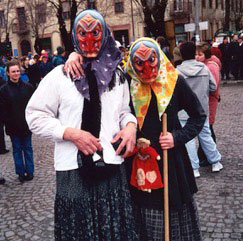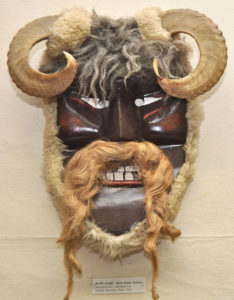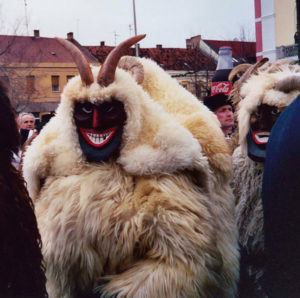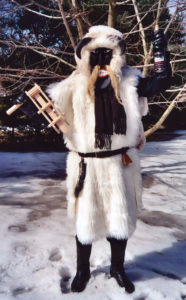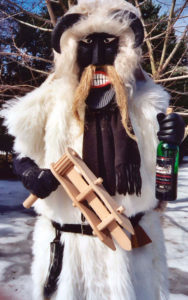BUSÓJÁRÁS
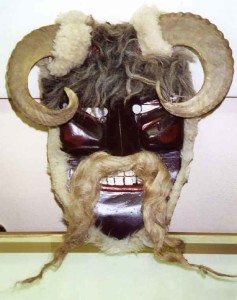
The following piece is about traditional Hungarian folk customs, which are extremely fascinating, imaginative, and amusing, specifically: Hungarian carnival season masquerading practices.
The months of the late autumn and winter seasons are a time of the year when the sky is dark and gray, the landscape is dull brown, the trees are bare, creating a spooky and frightening effect, and there is a bleakness, a dreariness, and a gloominess floating about in the air. So, it seems fitting that we have been pleasantly blessed with a series of festive, colorful holidays to brighten up these seasons and to add a touch of warmth to the spirit of humanity. Some of these include All Hallows’ Eve (Halloween), Thanksgiving, Saint Nicholas’ Eve (and day), Saint Lucia Day, Advent, Christmas, New Year’s Eve, Epiphany (Vízkereszt in Hungarian), Carnival, and Saint Valentine’s Day.
Carnival is a season of merry-making, which celebrates the burial or the end of winter and it is a welcoming of springtime. It originated from ancient times as a spring fertility ritual. It lasts from Epiphany (January 6th) to Shrove Tuesday (húshagyó-kedd) – the day before Ash Wednesday, the start of Lent, which is a period of fasting. Some famous carnivals around the world occur in: Venice, Italy; Rio de Janeiro, Brazil; New Orleans, Louisiana (Mardi Gras); and Hungarian “Farsang” celebrations including the Busójárás Carnival in Mohács, southern Hungary. VisitEurope.com lists the major carnivals in Europe. During Farsang, there is the fanciful, exquisite, and elegant as well as the fun, casual, and light-hearted. Like long ago, today there occur costume balls, dances, parties, parades, masquerading, and other strange and unusual fascinating practices that involve native traditional Folk customs. Some customs found in Hungarian villages include coloring children’s faces black with soot, giving them a stick, and having them go from door to door in the neighborhood (like trick-or-treating) asking for a piece of bacon to stick on the end of their rod, which they later roast on a burning fire and eat merrily while singing. They’d also eat fánk which are Hungarian donuts. Also, in Szeged on the Saturday before Farsang Vasárnap (Sunday), there is a burning of a straw witch which is then thrown into the Tisza River and which is likely to cast out sickness and evil spirits from the village. This was even shown on Hungarian television.
The Fanta Carnival in Vörösmarty Tér, Budapest, is one of the year’s Farsang celebrations and it includes a parade and a costume contest with special surprise appearances typically by Saint Nicholas, a Kossuth Lajos impersonator, a king and his knights, a krampusz (devilish monster), a busójáró (masked beast), masked Venetian carnivalers, harlequins and clowns, uniformed marching bands, and many others including a lot of children.
A good intention is to visit Mohács in late winter to see for oneself this terrific part of Hungarian culture. During a visit to Hungary, one has the opportunity to go to Mohács and put the experience and learning about the busó customs into one’s memory.
Wonderful Farsang Vasárnap in Mohács is experienced by tourists via a bus trip on an Ibusz tour bus departing from Heroes Square (Hősök-tere) in Budapest. Visits include Szekszárd, a wine region city with a lovely Roman Catholic church and scenic and picturesque views of the surrounding countryside from a lookout, a restaurant Erzsébet Söröző in Bóly, the Mohácsi Memorial Battlefield Monument, and finally the town of Mohács for the much-awaited focal point and exciting climax of the tour-busójárás.
The practice of busójárás is performed in Mohács by the Sokác people, and it is found as well in Slovenia and Croatia also. The legend and belief also exists that this frightful ferocity was a battle technique to inspire fear in the troops of the Ottoman Turks to force their retreat and rid them from the land.
The Busójárás Carnival in Mohács is a 6-day celebration in the year (usually during February). It starts with a Thursday opening, then Kisfarsang (little carnival) Friday, then the biggest day being Farsang vasárnap which occurs on the 7th Sunday before Easter, and it ends with Farsang Temetés (Burial) Tuesday. The extensive schedule of events, programs, and attractions is listed in Mohacs.hu, the city’s website. The day’s celebrations includes a parade of wild, fierce, ferocious, frightening noise-making busójárás. They wear grotesque masks with real horns and carved of wood and painted by local craftsmen and they also wear big animal-skin furs and cowbells. They walk and ride in carriages, even with a coffin called busó temető. Some of the busós offer fánk (donuts) on the end of pitchforks and some gently whack females with an object representing a symbol of fertility. Also during the festival, the busós ride in boats on the Danube River. There is a ton of people watching the parade of busó-járás, which goes down a main street leading to a central square next to an Orthodox Church. The main street is lined with vendors and it is a delight to be able to buy a mask, fur, noise-maker, and other related items. There is also a stage where the Mayor of Mohács gives his welcoming and where dance groups perform to music in different beautiful styles of dress. Even the busós take to the stage to make merry during the festivities! There is cannon-fire and some witches run around playing tricks in the square and even a white-masked Saint Lucy makes an appearance during the parade. As the evening is to grow dark, a huge bonfire in the middle of the square is lit, a straw dummy representing winter is burned in effigy, and the busós proceed to dance around the fire to the amazement and astonishment of the spectators. There are more busójárós participating each year than the year before.
It is a good idea to make a devotion to keeping these wonderful customs alive for the next generations to enjoy.

